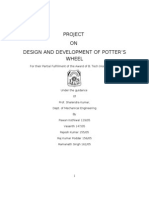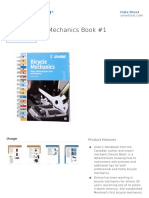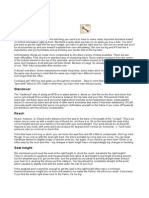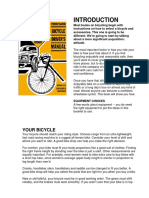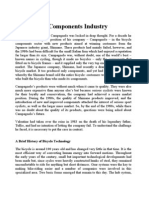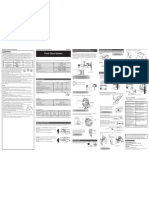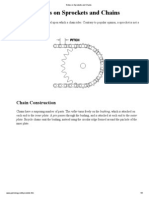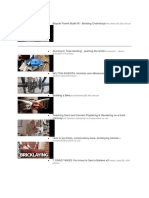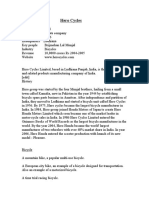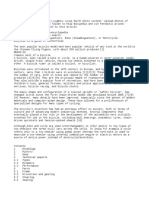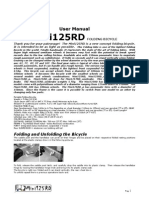Bicycle: From Wikipedia, The Free Encyclopedia
Bicycle: From Wikipedia, The Free Encyclopedia
Uploaded by
lunwenCopyright:
Available Formats
Bicycle: From Wikipedia, The Free Encyclopedia
Bicycle: From Wikipedia, The Free Encyclopedia
Uploaded by
lunwenOriginal Description:
Original Title
Copyright
Available Formats
Share this document
Did you find this document useful?
Is this content inappropriate?
Copyright:
Available Formats
Bicycle: From Wikipedia, The Free Encyclopedia
Bicycle: From Wikipedia, The Free Encyclopedia
Uploaded by
lunwenCopyright:
Available Formats
Bicycle - Wikipedia, the free encyclopedia
Page 1 of 17
Bicycle
From Wikipedia, the free encyclopedia
A bicycle, also known as a bike, pushbike or cycle, is a
pedal-driven, human-powered, single-track vehicle,
having two wheels attached to a frame, one behind the
other. A person who rides a bicycle is called a cyclist or
a bicyclist.
Bicycles were introduced in the 19th century and now
number about one billion worldwide, twice as many as
automobiles.[1] They are the principal means of
transportation in many regions. They also provide a
popular form of recreation, and have been adapted for
such uses as children's toys, adult fitness, military and
police applications, courier services and bicycle racing.
A mountain bike, a popular multi-use
bicycle.
The basic shape and configuration of a typical upright
bicycle has changed little since the first chain-driven
model was developed around 1885.[2] However, many
details have been improved, especially since the advent
of modern materials and computer-aided design. These
have allowed for a proliferation of specialized designs
for particular types of cycling.
The invention of the bicycle has had an enormous impact
on society, both in terms of culture and of advancing
modern industrial methods. Several components that
eventually played a key role in the development of the
automobile were originally invented for the bicycle
e.g., ball bearings, pneumatic tires, chain-driven
sprockets, spoke-tensioned wheels, etc.
A European city bike, an example of a
bicycle designed for transportation. Also
an example of a motorized bicycle.
Contents
1 History
2 Uses
3 Technical aspects
3.1 Types
3.2 Dynamics
3.3 Performance
3.4 Construction and parts
3.4.1 Frame
3.4.2 Drivetrain and gearing
3.4.3 Steering and seating
3.4.4 Brakes
3.4.5 Suspension
3.4.6 Wheels
http://en.wikipedia.org/wiki/Bicycle
A time trial racing bicycle.
17/04/2010
Bicycle - Wikipedia, the free encyclopedia
Page 2 of 17
3.4.7 Accessories, repairs, and
tools
3.4.8 Standards
3.4.9 Parts
4 Social and historical aspects
4.1 In daily life
4.2 Female emancipation
4.3 Economic implications
4.4 Legal requirements
5 See also
6 Notes
7 References
8 External links
History
Main article: History of the bicycle
Multiple innovators contributed to the history of the bicycle
by developing precursor human-powered vehicles. The
documented ancestors of today's modern bicycle were known
as draisines, hobby horses, or push bikes (and modern
bicycles are sometimes still called push bikes outside of
North America). Being the first human means of transport to
make use of the two-wheeler principle, the draisine (or
Laufmaschine, "running machine"), invented by the German
Baron Karl von Drais, is regarded as the forerunner of the
modern bicycle. It was introduced by Drais to the public in
Mannheim in summer 1817 and in Paris in 1818.[3] Its rider
sat astride a wooden frame supported by two in-line wheels
and pushed the vehicle along with his/her feet while steering
the front wheel.
Wooden draisine (around 1820), the
first two-wheeler and as such the
archetype of the bicycle
In the early 1860s,
Frenchmen Pierre
Michaux and Pierre
Lallement took
bicycle design in a
new direction by
adding a mechanical
crank drive with
pedals on an enlarged
front wheel (the
velocipede). Another
French inventor by
Thomas McCall in 1869 on his
Michaux' son on velocipede 1868
the name of Douglas
velocipede
Grasso had a failed
prototype of Pierre Lallement's bicycle several years earlier.
Several inventions followed using rear wheel drive, the best known being the rod-driven velocipede
by Scotsman Thomas McCall in 1869. The French creation, made of iron and wood, developed into
the "penny-farthing" (historically known as an "ordinary bicycle", a retronym, since there were then
no other kind).[4] It featured a tubular steel frame on which were mounted wire-spoked wheels with
http://en.wikipedia.org/wiki/Bicycle
17/04/2010
Bicycle - Wikipedia, the free encyclopedia
Page 3 of 17
solid rubber tires. These bicycles were difficult to ride due to their very high seat and poor weight
distribution.
The dwarf ordinary
addressed some of
these faults by
reducing the front
wheel diameter and
setting the seat further
back. This
necessitated the
addition of gearing,
effected in a variety
of ways, to efficiently
use the power
avaliable. However,
Bicycle in Plymouth, England at the
having to both pedal
start of the 20th century
A penny-farthing or ordinary
and steer via the front
bicycle photographed in the koda
wheel remained a
Auto museum in the Czech
problem. J. K. Starley, J. H. Lawson, and Shergold solved
Republic
this problem by introducing the chain drive (originated by the
unsuccessful "bicyclette" of Englishman Henry Lawson),[5]
connecting the frame-mounted cranks to the rear wheel. These models were known as dwarf safeties,
or safety bicycles, for their lower seat height and better weight distribution. (Although without
pneumatic tires the ride of the smaller wheeled bicycle would be much rougher than that of the larger
wheeled variety.) Starley's 1885 Rover is usually described as the first recognizably modern bicycle.
Soon, the seat tube was added, creating the double-triangle diamond frame of the modern bike.
Further innovations increased comfort and ushered in a second bicycle craze, the 1890s' Golden Age
of Bicycles. In 1888, Scotsman John Boyd Dunlop introduced the first practical pneumatic tire,
which soon became universal. Soon after, the rear freewheel was developed, enabling the rider to
coast. This refinement led to the 1898 invention of coaster brakes. Derailleur gears and handoperated cable-pull brakes were also developed during these years, but were only slowly adopted by
casual riders. By the turn of the century, cycling clubs flourished on both sides of the Atlantic, and
touring and racing became widely popular.
Bicycles and horse buggies were the two mainstays of private transportation just prior to the
automobile, and the grading of smooth roads in the late 19th century was stimulated by the
widespread advertising, production, and use of these devices.
Uses
Bicycles have been and are employed for many uses:
Utility: bicycle
commuting and utility
cycling
Work: mail delivery,
paramedics, police,
couriering, and
general delivery.
Recreation: bicycle
touring, mountain
http://en.wikipedia.org/wiki/Bicycle
Transporting milk churns in
Kolkata, India
17/04/2010
Bicycle - Wikipedia, the free encyclopedia
Working bicycle in Amsterdam,
Netherlands
Page 4 of 17
biking, BMX and physical fitness.
Racing: track racing, criterium, roller racing and time trial to
multi-stage events like the Tour of California, Giro d'Italia,
the Tour de France, the Vuelta a Espaa, the Volta a
Portugal, among others.
Military: scouting, troop movement, supply of provisions, and patrol. See bicycle infantry.
Show: entertainment and performance, e.g. circus clowns.
As a novelty musical instrument; e.g. Frank Zappa and P. D. Q. Bach.
Technical aspects
The bicycle has undergone continual adaptation and
improvement since its inception. These innovations have
continued with the advent of modern materials and computeraided design, allowing for a proliferation of specialized
bicycle types.
Types
Main article: List of bicycle types
A BMX bike, an example of a
bicycle designed for sport
Bicycles can be
A Half Wheeler trailer bike at the
categorized in
Golden Gate Bridge
different ways: e.g. by
function, by number
of riders, by general construction, by gearing or by means of
propulsion. The more common types include utility bicycles,
mountain bicycles, racing bicycles, touring bicycles, hybrid
bicycles, cruiser bicycles, and BMX Bikes. Less common are
tandems, lowriders, tall bikes, fixed gear, folding models and
recumbents (one of which was used to set the IHPVA Hour
record).
Unicycles, tricycles and quadracycles are not strictly
bicycles, as they have respectively one, three and four wheels, but are often referred to informally as
"bikes".
Dynamics
Main article: Bicycle and motorcycle dynamics
A bicycle stays upright while moving forward by being
steered so as to keep its center of gravity over the wheels.[6]
This steering is usually provided by the rider, but under
certain conditions may be provided by the bicycle itself.[7]
The combined center of mass of a bicycle and its rider must
lean into a turn to successfully navigate it. This lean is
induced by a method known as countersteering, which can be
performed by the rider turning the handlebars directly with
the hands[8] or indirectly by leaning the bicycle.[9]
http://en.wikipedia.org/wiki/Bicycle
Bicycles leaning in a turn
17/04/2010
Bicycle - Wikipedia, the free encyclopedia
Page 5 of 17
Short-wheelbase or tall bicycles, when braking, can generate enough stopping force at the front
wheel to flip longitudinally.[10] The act of purposefully using this force to lift the rear wheel and
balance on the front without tipping over is a trick known as a stoppie, endo or front wheelie.
Performance
Main article: Bicycle performance
The bicycle is extraordinarily efficient in both biological and mechanical terms. The bicycle is the
most efficient self-powered means of transportation in terms of energy a person must expend to
travel a given distance.[11] From a mechanical viewpoint, up to 99% of the energy delivered by the
rider into the pedals is transmitted to the wheels, although the use of gearing mechanisms may
reduce this by 1015%.[12][13] In terms of the ratio of cargo weight a bicycle can carry to total weight,
it is also an efficient means of cargo transportation.
A recumbent bicycle
A human traveling on a bicycle at low to medium speeds of
around 1015 mph (1525 km/h) uses only the energy
required to walk. Air drag, which is proportional to the
square of speed, requires dramatically higher power outputs
as speeds increase. If the rider is sitting upright, the rider's
body creates about 75% of the total drag of the bicycle/rider
combination. Drag can be reduced by seating the rider in a
supine position or a prone position, thus creating a recumbent
bicycle or human powered vehicle. Drag can also be reduced
by covering the bicycle with an aerodynamic fairing.
In addition, the carbon dioxide generated in the production and transportation of the food required by
the bicyclist, per mile traveled, is less than 1/10th that generated by energy efficient cars.[14]
Construction and parts
In its early years, bicycle construction drew on pre-existing technologies. More recently, bicycle
technology has in turn contributed ideas in both old and new areas.
Frame
Main article: Bicycle frame
The great majority of today's bicycles have a frame with
upright seating which looks much like the first chain-driven
bike.[2] Such upright bicycles almost always feature the
diamond frame, a truss consisting of two triangles: the front
triangle and the rear triangle. The front triangle consists of
the head tube, top tube, down tube and seat tube. The head
tube contains the headset, the set of bearings that allows the
fork to turn smoothly for steering and balance. The top tube
Diagram of a bicycle.
connects the head tube to the seat tube at the top, and the
down tube connects the head tube to the bottom bracket. The
rear triangle consists of the seat tube and paired chain stays and seat stays. The chain stays run
parallel to the chain, connecting the bottom bracket to the rear dropouts. The seat stays connect the
top of the seat tube (at or near the same point as the top tube) to the rear dropouts.
http://en.wikipedia.org/wiki/Bicycle
17/04/2010
Bicycle - Wikipedia, the free encyclopedia
Page 6 of 17
Historically, women's bicycle frames had a top tube that
connected in the middle of the seat tube instead of the top,
resulting in a lower standover height at the expense of
compromised structural integrity, since this places a strong
bending load in the seat tube, and bicycle frame members are
typically weak in bending. This design, referred to as a stepthrough frame, allows the rider to mount and dismount in a
dignified way while wearing a skirt or dress. While some
women's bicycles continue to use this frame style, there is
also a variation, the mixte, which splits the top tube laterally
into
two thinner top tubes that bypass the seat tube on each
A Triumph with a step-through
side
and connect to the rear dropouts. The ease of stepping
frame.
through is also appreciated by those with limited flexibility or
other joint problems. Because of its persistent image as a
"women's" bicycle, step-through frames are not common for larger frames.
Another style is the recumbent bicycle. These are inherently more aerodynamic than upright
versions, as the rider may lean back onto a support and operate pedals that are on about the same
level as the seat. The world's fastest bicycle is a recumbent bicycle but this type was banned from
competition in 1934 by the Union Cycliste Internationale.[15]
Historically, materials used in bicycles have followed a similar pattern as in aircraft, the goal being
high strength and low weight. Since the late 1930s alloy steels have been used for frame and fork
tubes in higher quality machines. Celluloid found application in mudguards, and aluminum alloys
are increasingly used in components such as handlebars, seat post, and brake levers. In the 1980s
aluminum alloy frames became popular for their lightness, and their affordability now makes them
common. More expensive carbon fiber and titanium frames are now also available, as well as
advanced steel alloys and even bamboo.[16]
Drivetrain and gearing
For more details on this topic, see bicycle gearing.
The drivetrain begins with pedals which rotate the cranks,
which are held in axis by the bottom bracket. Most bicycles
use a chain to transmit power to the rear wheel. A relatively
small number of bicycles use a shaft drive to transmit power.
A very small number of bicycles (mainly single-speed
bicycles intended for short-distance commuting) use a belt
drive as an oil-free way of transmitting power.
Since cyclists' legs are most efficient over a narrow range of
pedaling speeds (cadence), a variable gear ratio helps a
cyclist to maintain an optimum pedalling speed while
covering varied terrain. As a first approximation, utility
bicycles often use a hub gear with a small number (3 to 8) of
widely-spaced gears, road bicycles and racing bicycles use
derailleur gears with a moderate number (10 to 22) of closely
-spaced gears, while mountain bicycles, hybrid bicycles, and
touring bicycles use drailleur gears with a larger number (15
to 33) of moderately-spaced gears, often including an
extremely low gear (granny gear) for climbing steep hills.
http://en.wikipedia.org/wiki/Bicycle
A set of rear sprockets (also known
as a cassette) and a derailleur
17/04/2010
Bicycle - Wikipedia, the free encyclopedia
Page 7 of 17
Different gears and ranges of gears are appropriate for different people and styles of cycling. Multispeed bicycles allow gear selection to suit the circumstances: a cyclist could use a high gear when
cycling downhill, a medium gear when cycling on a flat road, and a low gear when cycling uphill. In
a lower gear every turn of the pedals leads to fewer rotations of the rear wheel. This allows the
energy required to move the same distance to be distributed over more pedal turns, reducing fatigue
when riding uphill, with a heavy load, or against strong winds. A higher gear allows a cyclist to
make fewer pedal turns to maintain a given speed, but with more effort per turn of the pedals.
With a chain drive transmission, a chainring attached to a
crank drives the chain, which in turn rotates the rear wheel
via the rear sprocket(s) (cassette or freewheel). There are four
gearing options: two-speed hub gear integrated with chain
ring, up to 3 chain rings, up to 11 sprockets, hub gear built in
to rear wheel (3-speed to 14-speed). The most common
options are either a rear hub or multiple chain rings combined
with multiple sprockets (other combinations of options are
possible but less common).
A bicycle with shaft drive instead of
With a shaft drive transmission, a gear set at the bottom
a chain
bracket turns the shaft, which then turns the rear wheel via a
gear set connected to the wheel's hub. There is some small
loss of efficiency due to the two gear sets needed. The only gearing option with a shaft drive is to use
a hub gear.
Steering and seating
The handlebars turn the fork and the front wheel via the stem, which rotates within the headset.
Three styles of handlebar are common. Upright handlebars, the norm in Europe and elsewhere until
the 1970s, curve gently back toward the rider, offering a natural grip and comfortable upright
position. Drop handlebars "drop" as they curve forward and down, offering the cyclist best braking
power from a more aerodynamic "crouched" position, as well as more upright positions in which the
hands grip the brake lever mounts, the forward curves, or the upper flat sections for increasingly
upright postures. Mountain bikes generally feature a 'straight handlebar' or 'riser bar' with varying
degrees of sweep backwards and centimeters rise upwards, as well as wider widths which can
provide better handling due to increased leverage against the wheel.
A Selle San Marco saddle designed
for women
Saddles also vary with rider preference, from the cushioned
ones favored by short-distance riders to narrower saddles
which allow more room for leg swings. Comfort depends on
riding position. With comfort bikes and hybrids, cyclists sit
high over the seat, their weight directed down onto the
saddle, such that a wider and more cushioned saddle is
preferable. For racing bikes where the rider is bent over,
weight is more evenly distributed between the handlebars and
saddle, the hips are flexed, and a narrower and harder saddle
is more efficient. Differing saddle designs exist for male and
female cyclists, accommodating the genders' differing
anatomies, although bikes typically are sold with saddles
most appropriate for men.
A recumbent bicycle has a reclined chair-like seat that some riders find more comfortable than a
saddle, especially riders who suffer from certain types of seat, back, neck, shoulder, or wrist pain.
Recumbent bicycles may have either under-seat or over-seat steering.
http://en.wikipedia.org/wiki/Bicycle
17/04/2010
Bicycle - Wikipedia, the free encyclopedia
Page 8 of 17
Brakes
Main article: Bicycle brake systems
Modern bicycle brakes may be: rim brakes, in which friction
pads are compressed against the wheel rims; internal hub
brakes, in which the friction pads are contained within the
wheel hubs; or disc brakes, with a separate rotor for braking.
Disc brakes are more common on off-road bicycles, tandems
and recumbent bicycles than on road-specific bicycles.
A front disc brake, mounted to the
fork and hub
With hand-operated
brakes, force is
applied to brake
levers mounted on the
handlebars and
transmitted via
Bowden cables or
hydraulic lines to the
Linear-pull brake, also known by
friction pads. A rear
the
Shimano trademark: V-Brake,
hub brake may be
on rear wheel of a mountain bike
either hand-operated
or pedal-actuated, as
in the back pedal coaster brakes which were popular in North
America until the 1960s, and are common in children's
bicycles.
Track bicycles do not have dedicated brakes. Brakes are not required for riding on a track because all
riders ride in the same direction around a track which does not necessitate sharp deceleration. Track
riders are still able to slow down because all track bicycles are fixed-gear, meaning that there is no
freewheel. Without a freewheel, coasting is impossible, so when the rear wheel is moving, the crank
is moving. To slow down, the rider applies resistance to the pedals this acts as a braking system
which can be as effective as a friction-based rear wheel brake, but not as effective as a front wheel
brake.[17]
Suspension
Main article: Bicycle suspension
Bicycle suspension refers to the system or systems used to suspend the rider and all or part of the
bicycle. This serves two purposes:
To keep the wheels in continuous contact with rough surfaces to improve control.
To isolate the rider and luggage from jarring due to rough surfaces.
Bicycle suspensions are used primarily on mountain bicycles, but are also common on hybrid
bicycles, and can even be found on some road bicycles, as they can help deal with problematic
vibration. Suspension is especially important on recumbent bicycles, since while an upright bicycle
rider can stand on the pedals to achieve some of the benefits of suspension, a recumbent rider cannot.
Wheels
Main article: Bicycle wheel
http://en.wikipedia.org/wiki/Bicycle
17/04/2010
Bicycle - Wikipedia, the free encyclopedia
Page 9 of 17
The wheel axle fits into dropouts in the frame and forks. A pair of wheels may be called a wheelset,
especially in the context of ready-built "off the shelf", performance-oriented wheels.
Tires vary enormously. Skinny 18 to 25 millimeters wide, road-racing tires may be completely
smooth, or (slick). On the opposite extreme, off-road tires are 38 to 64 millimeters wide and usually
have a deep tread for gripping in muddy conditions or metal spikes for ice.
Accessories, repairs, and tools
Some components, which are often optional accessories on
sports bicycles, are standard features on utility bicycles to
enhance their usefulness and comfort. Mudguards, or fenders,
protect the cyclist and moving parts from spray when riding
through wet areas and chainguards protect clothes from oil on
the chain while preventing clothing from being caught
between the chain and crankset teeth. Kick stands keep a
bicycle upright when parked, while a bike lock will help
prevent it from being stolen. Front-mounted baskets for
carrying goods are often used. Luggage carriers and panniers
mounted above the rear tire can be used to carry equipment
or cargo. Parents sometimes add rear-mounted child seats
and/or an auxiliary saddle fitted to the crossbar to transport
children.
Touring bicycle equipped with head
lamp, pump, rear rack, fenders/mudguards, water bottles and cages, and
numerous saddle-bags.
Toe-clips and toestraps and clipless pedals help keep the foot
locked in the proper position on the pedals, and enable the
cyclist to pull as well as push the pedalsalthough not
without their hazards, e.g. may lock foot in when needed to
prevent a fall. Technical accessories include cyclocomputers
for measuring speed, distance, heart rate, GPS data etc. Other
accessories include lights, reflectors, security locks, mirror,
water bottles and cages, and bell.[18]
Bicycle helmets may help reduce injury in the event of a
collision or accident, and a certified helmet is legally required
for some riders in some jurisdictions. Helmets are classified
as an accessory[18] or an item of clothing by others.[19]
Puncture repair kit with tire levers,
sandpaper to clean off an area of the
inner tube around the puncture, a
tube of rubber solution (vulcanizing
fluid), round and oval patches, a
metal grater and piece of chalk to
make chalk powder (to dust over
excess rubber solution). Kits often
also include a wax crayon to mark
the puncture location.
Many cyclists carry tool kits. These may include a tire patch
kit (which, in turn, may contain any combination of a hand
pump or CO2 Pump, tire levers, spare tubes, self-adhesive
patches, or tube-patching material, an adhesive, a piece of
sandpaper or a metal grater (for roughing the tube surface to
be patched),[20][21] and sometimes even a block of French
chalk.), wrenches, hex keys, screwdrivers, and a chain tool.
There are also cycling specific multi-tools that combine many of these implements into a single
compact device. More specialized bicycle components may require more complex tools, including
proprietary tools specific for a given manufacturer.
Some bicycle parts, particularly hub-based gearing systems, are complex, and many cyclists prefer to
leave maintenance and repairs to professional bicycle mechanics. In some areas it is possible to
purchase road-side assistance from companies such as the Better World Club. Other cyclists
maintain their own bicycles, perhaps as part of their enjoyment of the hobby of cycling or simply for
http://en.wikipedia.org/wiki/Bicycle
17/04/2010
Bicycle - Wikipedia, the free encyclopedia
Page 10 of 17
economic reasons. The ability to repair and maintain your own bicycle is also celebrated within the
DIY movement.
Standards
A number of formal and industry standards exist for bicycle components to help make spare parts
exchangeable and to maintain a minimum product safety.
The International Organization for Standardization, ISO, has a special technical committee for
cycles, TC149, that has the following scope: "Standardization in the field of cycles, their components
and accessories with particular reference to terminology, testing methods and requirements for
performance and safety, and interchangeability."
CEN, European Committee for Standardisation, also has a specific Technical Committee, TC333,
that defines European standards for cycles. Their mandate states that EN cycle standards shall
harmonize with ISO standards. Some CEN cycle standards were developed before ISO published
their standards, leading to strong European influences in this area. European cycle standards tend to
describe minimum safety requirements, while ISO standards have historically harmonized parts
geometry.[22]
Parts
For details on specific bicycle parts, see list of bicycle parts and category:bicycle parts.
Social and historical aspects
The bicycle has had a considerable effect on human society, in both the cultural and industrial
realms.
In daily life
Around the turn of the 20th century, bicycles reduced crowding in inner-city tenements by allowing
workers to commute from more spacious dwellings in the suburbs. They also reduced dependence on
horses. Bicycles allowed people to travel for leisure into the country, since bicycles were three times
as energy efficient as walking and three to four times as fast.
A bike-sharing station in Barcelona
Recently, several European cities and Montreal have
implemented successful schemes known as community
bicycle programs or bike-sharing. These initiatives
complement a city's public transport system and offer an
alternative to motorized traffic to help reduce congestion and
pollution. In Europe, especially in The Netherlands and parts
of Germany and Denmark, commuting by bicycle is very
common. In The Netherlands, all train stations are equipped
with provisions for bicycle parking for a small fee and the
larger ones also with bicycle repair shops, and cycling is so
popular that the parking capacity is sometimes exceeded.[23]
In Trondheim in Norway, the Trampe bicycle lift has been
developed to encourage cyclists by giving assistance on a
steep hill.
In cities where the bicycle is not an integral part of the planned transportation system, commuters
often use bicycles as elements of a mixed-mode commute, where the bike is used to travel to and
http://en.wikipedia.org/wiki/Bicycle
17/04/2010
Bicycle - Wikipedia, the free encyclopedia
Page 11 of 17
from train stations or other forms of rapid transit. Folding bicycles are useful in these scenarios, as
they are less cumbersome when carried aboard. Los Angeles removed a small amount of seating on
some trains to make more room for bicycles and wheel chairs.[24]
Bicycles offer an important mode of transport in many developing countries. Until recently, bicycles
have been a staple of everyday life throughout Asian countries. They are the most frequently used
method of transport for commuting to work, school, shopping, and life in general.
Female emancipation
The safety bicycle gave women unprecedented mobility,
contributing to their emancipation in Western nations. As
bicycles became safer and cheaper, more women had access
to the personal freedom they embodied, and so the bicycle
came to symbolize the New Woman of the late 19th century,
especially in Britain and the United States. The bicycle was
recognized by 19th-century feminists and suffragists as a
"freedom machine" for women. American Susan B. Anthony
said in a New York World interview on February 2, 1896:
"Let me tell you what I think of bicycling. I think it has done
more to emancipate women than anything else in the world.
It gives women a feeling of freedom and self-reliance. I stand
and rejoice every time I see a woman ride by on a wheel...the
picture of free, untrammeled womanhood." In 1895 Frances
Willard, the tightly-laced president of the Womens Christian
Temperance Union, wrote a book called How I Learned to
Ride the Bicycle, in which she praised the bicycle she learned
to ride late in life, and which she named "Gladys", for its
"gladdening effect" on her health and political optimism.
Willard used a cycling metaphor to urge other suffragists to
action, proclaiming, "I would not waste my life in friction
when it could be turned into momentum."
Woman with bicycle, 1890s
Male anger at the freedom symbolized by the New
(bicycling) Woman was demonstrated when the male undergraduates of Cambridge University
showed their opposition to the admission of women as full members of the university by hanging a
woman bicyclist in effigy in the main town square. This was as late as 1897.[25] The bicycle craze in
the 1890s also led to a movement for so-called rational dress, which helped liberate women from
corsets and ankle-length skirts and other restrictive garments, substituting the then-shocking
bloomers.
Economic implications
Bicycle manufacturing proved to be a training ground for other industries and led to the development
of advanced metalworking techniques, both for the frames themselves and for special components
such as ball bearings, washers, and sprockets. These techniques later enabled skilled metalworkers
and mechanics to develop the components used in early automobiles and aircraft.
They also served to teach the industrial models later adopted, including mechanization and mass
production (later copied and adopted by Ford and General Motors),[26] vertical integration[27] (also
later copied and adopted by Ford), aggressive advertising[28] (as much as 10% of all advertising in
U.S. periodicals in 1898 was by bicycle makers),[29] lobbying for better roads (which had the side
benefit of acting as advertising, and of improving sales by providing more places to ride),[30] all first
http://en.wikipedia.org/wiki/Bicycle
17/04/2010
Bicycle - Wikipedia, the free encyclopedia
Page 12 of 17
practised by Pope.[30] In addition, bicycle makers adopted the
annual model change[31][32] (later derided as planned
obsolescence, and usually credited to General Motors), which
proved very successful.[33]
Furthermore, early bicycles were an example of conspicuous
consumption, being adopted by the fashionable elites.[34] In
addition, by serving as a platform for accessories, which
could ultimately cost more than the bicycle itself, it paved the
way for the likes of the Barbie doll.[35]
Columbia Bicycles advertisement
from 1886
Moreover, they helped create, or enhance, new kinds of
businesses, such as bicycle messengers,[36] travelling
seamstresses,[37] riding academies,[38] and racing rinks[39]
(Their board tracks were later adapted to early motorcycle
and automobile racing.) Also, there were a variety of new
inventions, such as spoke tighteners,[40] and specialized
lights,[41] socks and shoes,[42] and even cameras (such as the
Eastman Company's Poco).[43] Probably the best known and
most widely used of these inventions, adopted well beyond
cycling, is Charles Bennett's Bike Web, which came to be
called the "jock strap".[44]
They also presaged a move away from public transit[45] that
would explode with the introduction of the automobile.
J. K. Starley's company became the Rover Cycle Company
Ltd. in the late 1890s, and then simply the Rover Company
when it started making cars. The Morris Motor Company (in
Oxford) and koda also began in the bicycle business, as did
the Wright brothers.[46] Alistair Craig, whose company
eventually emerged to become the engine manufacturers
Ailsa Craig, also started from manufacturing bicycles, in
Glasgow in March 1885.
In general, U.S. and European cycle manufacturers used to
assemble cycles from their own frames and components
made by other companies, although very large companies
(such as Raleigh) used to make almost every part of a bicycle
(including bottom brackets, axles, etc.) In recent years, those
bicycle makers have greatly changed their methods of
production. Now, almost none of them produce their own
frames.
A man uses a bicycle to carry goods
in Ouagadougou, Burkina Faso
Many newer or smaller companies only design and market their products; the actual production is
done by Asian companies. For example, some 60% of the world's bicycles are now being made in
China. Despite this shift in production, as nations such as China and India become more wealthy,
their own use of bicycles has declined due to the increasing affordability of cars and motorcycles.
[citation needed]
One of the major reasons for the proliferation of Chinese-made bicycles in foreign
markets is the lower cost of labor in China.[47]
http://en.wikipedia.org/wiki/Bicycle
17/04/2010
Bicycle - Wikipedia, the free encyclopedia
Page 13 of 17
One of the profound economic implications of bicycle use is that it liberates the user from oil
consumption (Ballantine, 1972). The bicycle is a inexpensive, fast, healthy and environmentally
friendly mode of transport (Illich, 1974)
Legal requirements
Early in its development, as with automobiles, there were
restrictions on the operation of bicycles. Along with
advertising, and to gain free publicity, Albert A. Pope
litigated on behalf of cyclists.[48]
The 1968 Vienna Convention on Road Traffic of the United
Nations considers a bicycle to be a vehicle, and a person
controlling a bicycle (whether actually riding or not) is
considered an operator. The traffic codes of many countries
reflect these definitions and demand that a bicycle satisfy
certain legal requirements before it can be used on public
roads. In many jurisdictions, it is an offense to use a bicycle
that is not in a roadworthy condition.
Reflectors for riding after dark
In most jurisdictions, bicycles must have functioning front
and rear lights when ridden after dark. As some generator or
dynamo-driven lamps only operate while moving, rear reflectors are frequently also mandatory.
Since a moving bicycle makes little noise, some countries insist that bicycles have a warning bell for
use when approaching pedestrians, equestrians, and other cyclists.
Some countries require child and/or adult cyclists to wear helmets, as this may protect riders from
head trauma. Countries which require adult cyclists to wear helmets include Spain, Canada, New
Zealand and Australia.
See also
Cycling use of bicycles
General
Bicycle commuting
Bicycle industry and List of bicycle manufacturing companies
Bicycle law
Bicycle lighting
Bicycle lock
Bicycle locker
Bicycle safety
Bicycle tools
List of bicycle and human powered vehicle museums
List of bicycle parts
Special uses and related vehicle types
Balance bicycle
Beach cruiser
Bicycle trailer
http://en.wikipedia.org/wiki/Bicycle
17/04/2010
Bicycle - Wikipedia, the free encyclopedia
Page 14 of 17
Boda-boda
Cycle rickshaw
Faired bicycle
Bixi
Folding bicycle
Freight bicycle
Infantry bicycle
Monowheel
Quadracycle
Recumbent bicycle
Shaft-driven bicycle
Tandem bicycle
Trailer bike
Tricycle
Utility cycling
Unicycle
Velocipede
Velomobile
Workbike
Other
Human-powered transport
Safety standards
Transportation technology, timeline of
Notes
1. ^ DidYouKnow.org. There are about a billion or more bicycles in the world.
(http://www.didyouknow.org/bicycles.htm) Retrieved 30 July 2006.
2. ^ a b Herlihy, David V. (2004). Bicycle: the history. Yale University Press. pp. 200250. ISBN 0-30010418-9.
3. ^ "Canada Science and Technology Museum: Baron von Drais
Bicycle" (http://www.sciencetech.technomuses.ca/english/collection/cycles2.cfm) . 2006.
http://www.sciencetech.technomuses.ca/english/collection/cycles2.cfm. Retrieved 2006-12-23.
4. ^ Norcliffe, Glen. The Ride to Modernity: The Bicycle in Canada, 1869-1900 (Toronto: University of
Toronto Press, 2001), p.50, citing Derek Roberts.
5. ^ Norcliffe, p.47.
6. ^ Various (9 December 2006). "Like falling
off" (http://www.newscientist.com/article/mg19225812.400) . New Scientist (2581): 93.
http://www.newscientist.com/article/mg19225812.400. Retrieved 27 January 2009.
7. ^ Meijaard, Papadopoulos, Ruina, and Schwab, J.P.; Papadopoulos, Jim M.; Ruina, Andy; Schwab, A.L.
(2007). "Linearized dynamics equations for the balance and steer of a bicycle: a benchmark and review".
Proc. R. Soc. A. 463 (2084): 19551982. doi:10.1098/rspa.2007.1857 (http://dx.doi.org/10.1098%
2Frspa.2007.1857) .
8. ^ Wilson, David Gordon; Jim Papadopoulos (2004). Bicycling Science (Third ed.). The MIT Press.
pp. 270272. ISBN 0-262-73154-1.
9. ^ Fajans, Joel (July 2000). "Steering in bicycles and
motorcycles" (http://socrates.berkeley.edu/~fajans/pub/pdffiles/SteerBikeAJP.PDF) (PDF). American
Journal of Physics 68 (7): 654659. doi:10.1119/1.19504 (http://dx.doi.org/10.1119%2F1.19504) .
http://socrates.berkeley.edu/~fajans/pub/pdffiles/SteerBikeAJP.PDF. Retrieved 2006-08-04.
10. ^ Cossalter, Vittore (2006). Motorcycle Dynamics (Second ed.). Lulu.com. pp. 241342. ISBN 978-14303-0861-4.
11. ^ "Bicycle Technology", S.S. Wilson, Scientific American, March 1973
12. ^ "Johns Hopkins Gazette" (http://www.jhu.edu/~gazette/1999/aug3099/30pedal.html) , 30 August 1999
13. ^ Whitt, Frank R.; David G. Wilson (1982). Bicycling Science (Second ed.). Massachusetts Institute of
Technology. pp. 277300. ISBN 0-262-23111-5.
http://en.wikipedia.org/wiki/Bicycle
17/04/2010
Bicycle - Wikipedia, the free encyclopedia
Page 15 of 17
14. ^ How Much Do Bicycles Pollute? Looking at the Carbon Dioxide Produced by Bicycles
(http://www.kenkifer.com/bikepages/advocacy/bike_co2.htm)
15. ^ History Loudly Tells Why The Recumbent Bike Is Popular Today (http://www.recumbent-bikes-truthfor-you.com/history.html)
16. ^ Lukenbill, Jen (13 February 2008). "Bamboo
bikes" (http://www.aboutmyplanet.com/environment/bamboo-bikes/) . AboutMyPlanet.com.
http://www.aboutmyplanet.com/environment/bamboo-bikes/.
17. ^ Brown, Sheldon. "Fixed Gear Conversions: Braking" (http://www.sheldonbrown.com/fixed.html) .
http://www.sheldonbrown.com/fixed.html. Retrieved 2009-02-11.
18. ^ a b Bluejay, Michael. "Safety Accessories" (http://bicycleuniverse.info/eqp/accessories.html#safety) .
Bicycle Accessories. BicycleUniverse.info. http://bicycleuniverse.info/eqp/accessories.html#safety.
Retrieved 2006-09-13.
19. ^ "The Essentials of Bike Clothing" (http://bicycling.about.com/library/weekly/aa041098.htm) . About
Bicycling. About.com. http://bicycling.about.com/library/weekly/aa041098.htm. Retrieved 2006-09-13.
20. ^ "Sheldon Brown: Flat tires" (http://sheldonbrown.com/flats.html#patching) .
http://sheldonbrown.com/flats.html#patching. Retrieved 2008-05-29.
21. ^ "BikeWebSite: Bicycle Glossary Patch kit" (http://www.bikewebsite.com/bikeop.htm) .
http://www.bikewebsite.com/bikeop.htm. Retrieved 2008-06-20.
22. ^ The TC149 ISO bicycle committee, including the TC149/SC1 ("Cycles and major sub-assemblies")
subcommittee, has published the following standards:
ISO 4210 CyclesSafety requirements for bicycles
ISO 6692 CyclesMarking of cycle components
ISO 6695 CyclesPedal axle and crank assembly with square end fittingAssembly dimensions
ISO 6696 CyclesScrew threads used in bottom bracket assemblies
ISO 6697 CyclesHubs and freewheelsAssembly dimensions
ISO 6698 CyclesScrew threads used to assemble freewheels on bicycle hubs
ISO 6699 CyclesStem and handlebar bendAssembly dimensions
ISO 6701 CyclesExternal dimensions of spoke nipples
ISO 6742 CyclesLighting and retro-reflective devicesPhotometric and physical requirements
ISO 8090 CyclesTerminology (same as BS 6102-4)
ISO 8098 CyclesSafety requirements for bicycles for young children
ISO 8488 CyclesScrew threads used to assemble head fittings on bicycle forks
ISO 8562 CyclesStem wedge angle
ISO 10230 CyclesSplined hub and sprocketMating dimensions
ISO 11243 CyclesLuggage carriers for bicyclesConcepts, classification and testing
Other ISO Technical Committees have published various cycle relevant standards, for example:
ISO 5775 Bicycle tire and rim designations
ISO 9633 Cycle chainsCharacteristics and test methods
Published cycle standards from CEN TC333 include:
EN 14764 City and trekking bicycles Safety requirements and test methods
EN 14765 Bicycles for young children Safety requirements and test methods
EN 14766 Mountain-bicycles Safety requirements and test methods
EN 14781 Racing bicycles Safety requirements and test methods
EN 14782 Bicycles Accessories for bicycles Luggage carriers
EN 15496 Cycles Requirements and test methods for cycle locks
Yet to be approved cycle standards from CEN TC333:
EN 15194 CyclesElectrically power assisted cycles (EPAC bicycle)
EN 15532 CyclesTerminology
00333011 Cycles Bicycles trailers safety requirements and test methods
23. ^ Joel Broekaert and Reinier Kist (12 February 2010). "So many bikes, so little
space" (http://www.nrc.nl/international/article2482297.ece/So_many_bikes%2C_so_little_space) . NRC
Handelsblad. http://www.nrc.nl/international/article2482297.ece/So_many_bikes%2C_so_little_space.
Retrieved 2010-02-13.
24. ^ Damien Newton (October 16, 2008). "Metro Making Room for Bikes on Their
Trains" (http://la.streetsblog.org/2008/10/16/metro-making-room-for-bikes-on-their-trains/) .
LA.StreetsBlog.Org. http://la.streetsblog.org/2008/10/16/metro-making-room-for-bikes-on-their-trains/.
Retrieved 2010-02-12.
25. ^ "Newnham College Cambridge: The History of the College" (http://www.newn.cam.ac.uk/aboutnewnham/college-history/history/content/history-of-the-college-2) . Newnham College. 2009.
http://en.wikipedia.org/wiki/Bicycle
17/04/2010
Bicycle - Wikipedia, the free encyclopedia
26.
27.
28.
29.
30.
31.
32.
33.
34.
35.
36.
37.
38.
39.
40.
41.
42.
43.
44.
45.
46.
47.
48.
Page 16 of 17
http://www.newn.cam.ac.uk/about-newnham/college-history/history/content/history-of-the-college-2.
Retrieved 2010-02-12.
^ Norcliffe, Glen. The Ride to Modernity: The Bicycle in Canada, 1869-1900 (Toronto: University of
Toronto Press, 2001), pp.23, 106, & 108. GM's practice of sharing chassis, bodies, and other parts is
exactly what the early bicycle manufacturer Pope was doing.
^ Norcliffe, p.106.
^ Norcliffe, pp.14247.
^ Norcliffe, p.145.
^ a b Norcliffe, p.108.
^ Norcliffe, p.23.
^ Babaian, Sharon. The Most Benevolent Machine: A Historical Assessment of Cycles in Canada
(Ottawa: National Museum of Science and Technology, 1998), p.97.
^ Babaian, p.98.
^ Norcliffe, pp.8, 12, 14, 23, 1478, 1878, 208, & 2435.
^ Norcliffe, pp.23, 121, & 123.
^ Norcliffe, p.212.
^ Norcliffe, p.214.
^ Norcliffe, p.131.
^ Norcliffe, p.30 & 131.
^ Norcliffe, p.125.
^ Norcliffe, p.123 & 125.
^ Norcliffe, p.125 & 126.
^ Norcliffe, p.238.
^ Norcliffe, p.128.
^ Norcliffe, p.2145.
^ "The Wrights' bicycle shop" (http://www.nasm.si.edu/Wrightbrothers/who/1893/shop.cfm) . 2007.
http://www.nasm.si.edu/Wrightbrothers/who/1893/shop.cfm. Retrieved 2007-02-05.
^ The Economist, 15 February 2003
^ Norcliffe, Glen. The Ride to Modernity: The Bicycle in Canada, 1869-1900 (Toronto: University of
Toronto Press, 2001), p.108.
References
All About Bicycling, Rand McNally.
Richard Ballantine, Richard's Bicycle Book, Pan, 1975.
Caunter C. F. The History and Development of Cycles Science Museum London 1972.
Daniel Kirshner. Some nonexplanations of bicycle stability. American Journal of Physics, 48
(1), 1980. The abstract reads "In this paper we attempt to verify a nongyroscopic theory of
bicycle stability, and fail".
David B. Perry, Bike Cult: the Ultimate Guide to Human-powered Vehicles, Four Walls Eight
Windows, 1995.
Roni Sarig, The Everything Bicycle Book, Adams Media Corporation, 1997
"Randonneurs USA" (http://www.rusa.org/pbp.html) . PBP: Paris-Brest-Paris. March 31,
2005. http://www.rusa.org/pbp.html.
US Department of Transportation, Federal Highway Administration. "America's Highways
1776-1976", pp. 4243. Washington, DC, US Government Printing Office.
David Gordon Wilson, Bicycling Science, MIT press, ISBN 0-262-73154-1
David V. Herlihy, Bicycle: The History, Yale University Press, 2004
Frank Berto, The Dancing Chain: History and Development of the Derailleur Bicycle, San
Francisco: Van der Plas Publications, 2005, ISBN 1-892495-41-4.
The Data Book: 100 Years of Bicycle Component and Accessory Design, San Francisco: Van
der Plas Publications, 2005, ISBN 1-892495-01-5.
"Bicycle facts" (http://www.didyouknow.org/bicycles.htm) .
http://www.didyouknow.org/bicycles.htm. Retrieved 2006-07-25.
Other authors: Eddie Borysewicz, Greg LeMond, Davis Phinney, Connie Carpenter.
http://en.wikipedia.org/wiki/Bicycle
17/04/2010
Bicycle - Wikipedia, the free encyclopedia
Page 17 of 17
External links
Bicycle's As Generators (http://renewableenergyresource.net/diy-alternative-energy/bicyclegenerator) Explanation of how bicycle's can be used to generate electricity or power
electronics directly.
Pedaling History Museum (http://www.pedalinghistory.com/) The world's largest bicycle
museum
P.E.P.A. (http://www.pepa.gr/en/pepa.html) he official site of Cycling Association of
Veteran Athletes of Greece
Home Made Electric Bicycle (http://www.greenoptimistic.com/2008/04/16/home-madeelectric-bicycle/)
A range of Traffic Advisory Leaflets (http://www.dft.gov.uk/pgr/roads/tpm/tal/cyclefacilities/)
produced by the UK Department for Transport covering cycling.
Menotomy Vintage Bicycles (http://www.OldRoads.com/) Databases of antique bicycle
photos, features, price guide and research tools. Very large archives.
The Bicycle - Worlds most efficient form of transportation
(http://gotoes.org/bikestuff/index.htm) Discussion of the Bicycle and its advantages over
motor vehicles
Brown, Sheldon (http://sheldonbrown.com/) (2005). Extensive Online Bicycle Glossary
(http://sheldonbrown.com/glossary.html)
Hudson, William (2003). Myths and Milestones in Bicycle Evolution
(http://www.jimlangley.net/ride/bicyclehistorywh.html) . Retrieved March 30, 2005.
A History of Bicycles and Other Cycles
(http://www.sciencetech.technomuses.ca/english/collection/cycles.cfm) at the Canada Science
and Technology Museum
Jones, David E. H. (1970). The Stability of the Bicycle (http://istsocrates.berkeley.edu/~fajans/Teaching/MoreBikeFiles/JonesBikeBW.pdf) . Scanned in copy
for download for personal use.
The World Awheel: Early Cycling Books at the Lilly Library
(http://www.indiana.edu/~liblilly/awheel/awheel.html)
Bicycle Maintenance (http://en.wikibooks.org/wiki/Bicycles/Maintenance_and_Repair) :A
Wikibooks series
Bicycle Tutor (http://bicycletutor.com/) - Bicycle repair video tutorials.
Retrieved from "http://en.wikipedia.org/wiki/Bicycle"
Categories: Cycling | Cycle types | Human-powered vehicles | Sustainable technologies |
Appropriate technology
This page was last modified on 14 April 2010 at 12:35.
Text is available under the Creative Commons Attribution-ShareAlike License; additional
terms may apply. See Terms of Use for details.
Wikipedia is a registered trademark of the Wikimedia Foundation, Inc., a non-profit
organization.
http://en.wikipedia.org/wiki/Bicycle
17/04/2010
You might also like
- 4 Stroke Shift Kit Installation InstructionsDocument15 pages4 Stroke Shift Kit Installation InstructionsJ. RussellNo ratings yet
- Yamaha TDM850 '91-99 TRX850 '96-97 XTZ750 '89-95 Service ManualDocument211 pagesYamaha TDM850 '91-99 TRX850 '96-97 XTZ750 '89-95 Service ManualVictor Mtz100% (1)
- 2016 Commencal Supreme DH V4Document21 pages2016 Commencal Supreme DH V4SickLines100% (1)
- Original Parts CatalogueDocument46 pagesOriginal Parts CatalogueDAVID ANGEL SANTOS GUERRANo ratings yet
- Design and Development of Potter's WheelDocument26 pagesDesign and Development of Potter's WheelRaj Kumar100% (1)
- Section 15 PDFDocument56 pagesSection 15 PDFherrerafarid100% (2)
- Twerminal Velocity WheelbuildingDocument16 pagesTwerminal Velocity WheelbuildingJackson WallNo ratings yet
- Unior Bicycle Mechanics Book #1: Kat - Bikebook1Document2 pagesUnior Bicycle Mechanics Book #1: Kat - Bikebook1Putra KurniaNo ratings yet
- MTB Beginners GuideDocument4 pagesMTB Beginners GuideFrancis Jan Seth AlbaciteNo ratings yet
- Payment Card NumberDocument4 pagesPayment Card NumberlunwenNo ratings yet
- Yamaha R6 2007 Varios Modelos PDFDocument538 pagesYamaha R6 2007 Varios Modelos PDFCARLOSNo ratings yet
- Wheel and Rim Truing - WWW - Parktool - ComDocument5 pagesWheel and Rim Truing - WWW - Parktool - ComJose Luis SabinoNo ratings yet
- Sturmey Archer S RF3 Hub InstructionsDocument4 pagesSturmey Archer S RF3 Hub Instructionsdupazbita11No ratings yet
- Awc Src3 Manual. 1Document5 pagesAwc Src3 Manual. 1ghionoiucNo ratings yet
- Lacing WheelsDocument10 pagesLacing WheelsUmberto NicolisNo ratings yet
- 1Document34 pages1Vulebg Vukoic100% (2)
- How To Ride A BikeDocument9 pagesHow To Ride A BikeJacksoncj100% (1)
- BicycleDocument39 pagesBicycleMilan DasNo ratings yet
- Magic ManutenzioneDocument200 pagesMagic ManutenzioneJackson Wall100% (1)
- Specialized Bicycle Owner S Manual 1Document60 pagesSpecialized Bicycle Owner S Manual 1caiodm100% (1)
- Spoke Tension - The Definitive Guide To Spoke Tensioning - Spokecalc - IoDocument8 pagesSpoke Tension - The Definitive Guide To Spoke Tensioning - Spokecalc - IoJose Luis Sabino100% (1)
- Budget Chopper Bicycle Work in ProgressDocument21 pagesBudget Chopper Bicycle Work in ProgressMarius DanilaNo ratings yet
- Recumbent Bicycle Design: Steering and Ride Roughness FormulaDocument1 pageRecumbent Bicycle Design: Steering and Ride Roughness FormulaMarcel PiersonNo ratings yet
- Pamanual PDFDocument44 pagesPamanual PDFfocaxeNo ratings yet
- Rear Derailleur: Dealer's ManualDocument45 pagesRear Derailleur: Dealer's ManualSyafiq JasrinNo ratings yet
- 2013 Problem Solvers CatalogDocument44 pages2013 Problem Solvers CatalogRusty_Iron_Works100% (3)
- Sturmey-Archer SRF3 User ManualDocument4 pagesSturmey-Archer SRF3 User Manualksjack100% (1)
- HUMAN POWER No. 49.Document15 pagesHUMAN POWER No. 49.wattafillingNo ratings yet
- Bicycle Guide: San FranciscoDocument56 pagesBicycle Guide: San Franciscoandragardner1559100% (1)
- Sturmey Archer 8speedDocument2 pagesSturmey Archer 8speedLuvikas Maybe KscNo ratings yet
- The Bicycle Component IndustryDocument16 pagesThe Bicycle Component Industrypapazaa100% (1)
- MTB 3Document8 pagesMTB 3bveNo ratings yet
- Build A Bamboo Bicycle and Light It UpDocument33 pagesBuild A Bamboo Bicycle and Light It UpBernice BunceNo ratings yet
- Steering Geometry AnglesDocument12 pagesSteering Geometry AnglesMohit RanaNo ratings yet
- Sturmey-Archer AWC-SRC3-MANUAL PDFDocument5 pagesSturmey-Archer AWC-SRC3-MANUAL PDFtudorbusuiocNo ratings yet
- Bicycle ManualDocument48 pagesBicycle ManualUlisesDiToroNo ratings yet
- Alivio Front Drive SI-6KFFA - v1 - m56577569830565035Document1 pageAlivio Front Drive SI-6KFFA - v1 - m56577569830565035setze16setze16No ratings yet
- HUMAN POWER No. 51.Document13 pagesHUMAN POWER No. 51.wattafillingNo ratings yet
- Manitou Tower ServiceDocument35 pagesManitou Tower ServiceKélio Wolfrane Santos MachadoNo ratings yet
- DM BR0005 11 EngDocument37 pagesDM BR0005 11 EngSpeedyChixNo ratings yet
- HondaDocument37 pagesHondaPAVAN KALYAN AMGOTH100% (1)
- Half Bike Suspension Model SolidworksDocument59 pagesHalf Bike Suspension Model SolidworksRavi Kiran MeesalaNo ratings yet
- The Recumbent Bicycle DesignDocument1 pageThe Recumbent Bicycle DesignMarcel Pierson100% (1)
- (1915) Catalogue & Net Price List: No.39Document156 pages(1915) Catalogue & Net Price List: No.39Herbert Hillary Booker 2ndNo ratings yet
- Notes On Sprockets and ChainsDocument6 pagesNotes On Sprockets and ChainsBilal TayyabNo ratings yet
- FOX Shox 2009EnglishOMDocument322 pagesFOX Shox 2009EnglishOMmykeenzo5658100% (1)
- Cycle Maintenance: Brakes, Gears, Punctures and MoreDocument16 pagesCycle Maintenance: Brakes, Gears, Punctures and Moreprem543210% (1)
- Bike FitDocument7 pagesBike FitDamian O'SheaNo ratings yet
- Shimano 2015-2016 Road & MTN Bike Parts Compatibility - v029 - enDocument32 pagesShimano 2015-2016 Road & MTN Bike Parts Compatibility - v029 - enquestor4425No ratings yet
- Cycle Code 2016Document84 pagesCycle Code 2016meleyezNo ratings yet
- Bicycle Trailer PDFDocument7 pagesBicycle Trailer PDFPense Vie SauvageNo ratings yet
- Sidecar of BicycleDocument20 pagesSidecar of BicyclePankaj KumarNo ratings yet
- E Bike Owners ManualDocument16 pagesE Bike Owners ManualShrawan Kumar Jha100% (1)
- 2014-2015 Compatibility v010 enDocument28 pages2014-2015 Compatibility v010 enFreddy KruguerNo ratings yet
- Fit Calculator - Competitive CyclistDocument3 pagesFit Calculator - Competitive CyclistVT WyeeNo ratings yet
- Complete Tandem Bike BuildDocument15 pagesComplete Tandem Bike Buildmarandan85No ratings yet
- Bike Cassettes & Drivetrains - CompatibilityDocument2 pagesBike Cassettes & Drivetrains - CompatibilityKarel HarantNo ratings yet
- Bicycle Frame Build 08Document6 pagesBicycle Frame Build 08Radomir NesicNo ratings yet
- PROA BoatDocument5 pagesPROA BoatMarioNo ratings yet
- Hero CyclesDocument19 pagesHero CyclesAnkit BhanotNo ratings yet
- GoodfileDocument22 pagesGoodfilenilreoowNo ratings yet
- Twin BicycleDocument32 pagesTwin BicyclePrajyot SatkarNo ratings yet
- History: History of The BicycleDocument4 pagesHistory: History of The BicycleecoNo ratings yet
- Bicycle - WikipediaDocument167 pagesBicycle - Wikipediashrimati.usha.sharmaNo ratings yet
- Lenovo Ideapad 330S-15IKB GTX1050 Hardware Maintenance ManualDocument75 pagesLenovo Ideapad 330S-15IKB GTX1050 Hardware Maintenance ManuallunwenNo ratings yet
- 2CR China Radio Network: The First 24-Hours Chinese Radio Station in Sydney and MelbourneDocument2 pages2CR China Radio Network: The First 24-Hours Chinese Radio Station in Sydney and MelbournelunwenNo ratings yet
- Cross Border Movement Physical Currency 4657566Document2 pagesCross Border Movement Physical Currency 4657566lunwenNo ratings yet
- Chinese Zodiac: From Wikipedia, The Free EncyclopediaDocument10 pagesChinese Zodiac: From Wikipedia, The Free EncyclopedialunwenNo ratings yet
- The Australian High-Value Payments System: 1. Settlement of Payments in AustraliaDocument7 pagesThe Australian High-Value Payments System: 1. Settlement of Payments in AustralialunwenNo ratings yet
- 360 Bar and Dinings Restaurant Menus Spring 2016Document9 pages360 Bar and Dinings Restaurant Menus Spring 2016lunwenNo ratings yet
- Comics: Comics (from the Greek κωµικός, kōmikos "of or pertaining toDocument1 pageComics: Comics (from the Greek κωµικός, kōmikos "of or pertaining tolunwenNo ratings yet
- Central Coast BushwalksDocument124 pagesCentral Coast BushwalkslunwenNo ratings yet
- Butterfly: From Wikipedia, The Free EncyclopediaDocument15 pagesButterfly: From Wikipedia, The Free EncyclopedialunwenNo ratings yet
- Sketch Comedy: Sketch Comedy Consists of A Series of Short Comedy Scenes or Vignettes, Called "Sketches,"Document3 pagesSketch Comedy: Sketch Comedy Consists of A Series of Short Comedy Scenes or Vignettes, Called "Sketches,"lunwenNo ratings yet
- Scope of Work Template 01Document2 pagesScope of Work Template 01lunwenNo ratings yet
- TF053504Armenia Action PlanDocument84 pagesTF053504Armenia Action PlanlunwenNo ratings yet
- Fs Great DrivesDocument6 pagesFs Great DriveslunwenNo ratings yet
- Bicycle Motocross: Bicycle Motocross or BMX Is A Bicycle Designed For Dirt andDocument2 pagesBicycle Motocross: Bicycle Motocross or BMX Is A Bicycle Designed For Dirt andlunwenNo ratings yet
- Fictional Universe in Avatar: From Wikipedia, The Free EncyclopediaDocument8 pagesFictional Universe in Avatar: From Wikipedia, The Free EncyclopedialunwenNo ratings yet
- Baroque: /BƏ Roʊk/, BƏDocument10 pagesBaroque: /BƏ Roʊk/, BƏlunwenNo ratings yet
- Tax Deduction ChecklistDocument2 pagesTax Deduction ChecklistlunwenNo ratings yet
- Buying Land Building HomeDocument22 pagesBuying Land Building HomelunwenNo ratings yet
- PerformaDocument16 pagesPerformalunwenNo ratings yet
- Tiny House Plans Ebook PDFDocument11 pagesTiny House Plans Ebook PDFlunwenNo ratings yet
- How To Create A Certificate For A Website Using Iis 6 and CacertDocument13 pagesHow To Create A Certificate For A Website Using Iis 6 and CacertlunwenNo ratings yet
- Updated Specie BookDocument7 pagesUpdated Specie BooklunwenNo ratings yet
- Build Home Sample PagesDocument9 pagesBuild Home Sample PageslunwenNo ratings yet
- Creating A PDF With Embedded Fonts For MS Word: How To Embed FontsDocument5 pagesCreating A PDF With Embedded Fonts For MS Word: How To Embed FontslunwenNo ratings yet
- Keeway Speed 150 UseManual EngDocument33 pagesKeeway Speed 150 UseManual EngКонстантин ЗайцевNo ratings yet
- CHAIN CalculationDocument18 pagesCHAIN CalculationDmitrijs MuhinsNo ratings yet
- Manual Mini125RD 01onlineDocument24 pagesManual Mini125RD 01onlinew29hNo ratings yet
- Drive by Wire Go KartDocument66 pagesDrive by Wire Go KartBien Morfe100% (1)
- Electro Cycle E-4 Kit For Recumbent Bikes - Installation InstructionsDocument6 pagesElectro Cycle E-4 Kit For Recumbent Bikes - Installation InstructionsRamnarayan MeenaNo ratings yet
- rd-m592 2Document1 pagerd-m592 2faizgpNo ratings yet
- Ridley ManualDocument42 pagesRidley Manualsnaplink345No ratings yet
- 12) Front Derailleur InstallationDocument2 pages12) Front Derailleur InstallationJay ShamNo ratings yet
- Bicycle Gearing - WikipediaDocument65 pagesBicycle Gearing - WikipediaanilbabuNo ratings yet
- Shimano 2018-2019 Compatibility v037 enDocument53 pagesShimano 2018-2019 Compatibility v037 enKali L100% (1)
- XT FD & Crank InstallationDocument1 pageXT FD & Crank InstallationMarNo ratings yet
- Shimano Compatabilty PDFDocument28 pagesShimano Compatabilty PDFChristorey Abucay100% (1)
- Did CatalogDocument347 pagesDid CatalogJorge Eliecer RodriguezNo ratings yet
- 1700 Animated MechanismsDocument104 pages1700 Animated Mechanismsvrun100% (6)
- Shimano SLX HG81 Cassette Service ManualDocument1 pageShimano SLX HG81 Cassette Service ManualJose Luis GutierrezNo ratings yet
- Roller Chains Important Note: Typical Chain ArrangementDocument13 pagesRoller Chains Important Note: Typical Chain ArrangementRajeshNo ratings yet
- Shimano Saint-Zee RD Service ManualDocument1 pageShimano Saint-Zee RD Service ManualJose Luis GutierrezNo ratings yet
- Dartmoor 2012 Catalog FinalDocument23 pagesDartmoor 2012 Catalog FinalThomas SmithNo ratings yet
- Thunderbird Mining Systems - Drilling Efficiency Indicator (DEI)Document84 pagesThunderbird Mining Systems - Drilling Efficiency Indicator (DEI)Mohammad Fidi Abganis Hermawan0% (1)
- Ownersmanual Astrea-Prima en 07122014-1714Document49 pagesOwnersmanual Astrea-Prima en 07122014-1714Johan Lau55% (11)
- GoodfileDocument22 pagesGoodfilenilreoowNo ratings yet
- Roller Chain Drive Selection: Table 1 - Service FactorsDocument5 pagesRoller Chain Drive Selection: Table 1 - Service FactorsPercy TorresNo ratings yet
- Shimano Dealers ManualDocument175 pagesShimano Dealers ManualLuca Ele Ale Stefi100% (1)
- Report Roller ChainDocument11 pagesReport Roller ChainPejuangHati100% (1)
- Chain RollerDocument9 pagesChain Rolleradn1987No ratings yet




